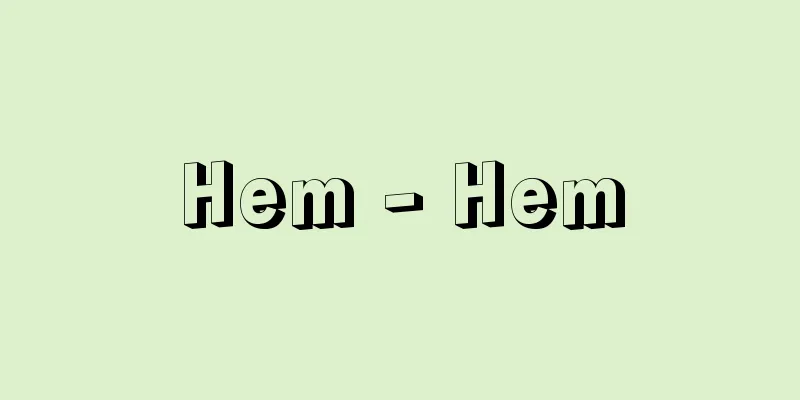Hem - Hem

[1] 〘noun〙① The bottom edge of a garment. The part that corresponds to the leg of a garment. ※Kojiki (712), song: “The moon has risen on the hem of the robe you are wearing .” ※Heike ( early 13th century), chapter 11: “Akitaro, who had advanced first, had his servants tied up in knots and led them into the sea.” ② A wide piece of cloth attached to the bottom of a robe or similar garment . Brocade . ※Kojiki (712), “Pierce a needle through a piece of hemp and stick it into the brocade hem of the garment.” ③ The foot of a mountain. The pedestal. Or the lower part of something that resembles a mountain. ※Omote Sachi Ku (1476) 2 "The deer that licks the leaves, even as they stand, (Zokuka) The white dew is deep at the foot of the mountain (Sōgi)" ※Haiku poem, Sora's Travel Diary (1689) Haiku written notes "In the evening, listening to the oxen riding out (Fūryū) Bonfires visible at the foot of the outskirts of the castle (Kohata)" ④ The bottom of a river. The downstream. ※Chuka Wakaki Shishō (around 1520) 1 "The seagulls are at the foot of the flowing water." ⑤ The bridge of something. The lower end or tip. ※Genji (around 1001-14) Wakana no Shita "The bottom of the koto peeks out slightly from under the screen." ⑥ The end of hair. The tip of hair. ※Tonbo (c. 974), part 2: "About four feet tall, and perhaps his hair has fallen off. It feels as though his hem is tattered, and is only about four inches tall." ⑦ The legs of the body. From the knee down. At the feet. ※Meitokuki (c. 1392-93), part 2: "Putting on his long armor, he turned around with his sword behind him and cut it off." ※Haikai, Kōya (1689), Ingai: "Someone came and draped a summer robe over his hem (Kikaku). Even the grinding of his teeth makes him look like he's in the morning (Etsujin)." ※Kaidan Botandōrō (1884), San'yūtei Enchō, part 8: "His face was completely pale, and he had no hem, so he was only above the waist." ⑧ The four legs of a horse. Also, to wash them. It also refers to the bath for washing. → To hem. ※Tsuruoka Hojoe Artisans' Poetry Contest (late 15th century) No. 9 "I will stop the sky-walking moon-haired horse and make its skirt in the Hinokuma River." ※Toraakirahon Kyogen: Jinba (late Muromachi period - early modern period) "If I were a horse, I would be the one to catch it. <omitted> Please make the skirt and other parts of it fine." ⑨ In Go, the lower part (near the edge of the board) that constitutes a certain area. [2] Abbreviation of "susotsugi (hem joint) (2)." ※Sharakuhon: Tomika Toyoshi (1782) "The middle town will be completed soon. The good is only the skirt, but it is called the middle because there is light in front."Kyo [hem]Source: The Selected Edition of the Japanese Language Dictionary About the Selected Edition of the Japanese Language Dictionary Information |
[1] 〘名〙① 衣服の下の縁(ふち)。衣服の脚にあたるところ。※古事記(712)中・歌謡「汝(な)が着(け)せる 襲(おすひ)の須蘇(スソ)に 月立ちにけり」※平家(13C前)一一「まっさきにすすんだる安芸太郎が郎等をすそをあはせて、海へどうどけいれ給ふ」② 袍(ほう)などの下端についている横幅の布。襴(らん)。※古事記(712)中「閇蘇(へそ)紡麻を針に貫きて、其の衣の襴(すそ)に刺せ」③ 山のふもと。山脚。裾野。あるいは、山のようになっているものの下端の部分。※表佐千句(1476)二「たちともしるしつまこふる鹿〈続家〉 しら露もさ山がすその月深て〈宗祇〉」※俳諧・曾良随行日記(1689)俳諧書留「乗放牛を尋る夕間暮〈風流〉 出城の裾に見ゆるかがり火〈木端〉」④ 川しも。下流。※中華若木詩抄(1520頃)上「鴎は其流水のすそにあれば」⑤ もののはし。下端や末の部分。※源氏(1001‐14頃)若菜下「みすの下より箏の御琴のすそ少しさしいでて」⑥ 髪の毛の末端。髪の毛の先。※蜻蛉(974頃)下「たけ四尺許にて、髪はおちたるにやあらん、すそさきたる心ちして、たけに四寸許ぞたらぬ」⑦ からだの足。膝から下。足もと。※明徳記(1392‐93頃か)中「長具足にてさしあはせ、太刀うしろへ立廻て、をきれ」※俳諧・曠野(1689)員外「誰か来て裾にかけたる夏衣〈其角〉 歯ぎしりにさへあかつきのかね〈越人〉」※怪談牡丹燈籠(1884)〈三遊亭円朝〉八「真青な顔で、裾がなくって腰から上ばかりで」⑧ 馬の四足。また、それを洗うこと。洗い湯のことにもいう。→裾をする。※鶴岡放生会職人歌合(15C後か)九番「御空行月毛の駒をひきとめてひのくま川にすそやあらはん」※虎明本狂言・人馬(室町末‐近世初)「身共が馬になったらば、馬とりは則そちであらうが〈略〉すそなどをも、さいさいしてくれさしめ」⑨ 囲碁で、一定の地域を構成している下方の(盤端に近い)部分。[2] 「すそつぎ(裾継)(二)」の略。※洒落本・登美賀遠佳(1782)「すぐに中町はとうだらう。善はすそくらいなれど、光がまへが有ゆへ、中といふ」
きょ【裾】出典 精選版 日本国語大辞典精選版 日本国語大辞典について 情報 |
Recommend
Agera method - Agera method
…The method for measuring this semi-quantitativel...
Wala (English spelling)
765 koro-835 Abbot of the Abbey of Corbie in Franc...
Ise Grand Shrine
Another name for Ise Shrine. Source: The Selected ...
Allosaurus fragilis (English spelling) Allosaurusfragilis
…A carnivorous dinosaur named by O.C. Marsh in 18...
Yue Yi; Yüeh I
A Chinese military commander active in the first h...
Tomisato [town] - Tomisato
A former town in Inba County, located in the cente...
Henri (English spelling) Robert Henri
1865‐1929 A realist painter who played a leading r...
Dictionary of Education
...Furthermore, in the 1930s, the Iwanami Lecture...
Setar (English spelling) setār Persian
A plucked string instrument of the Iranian lute f...
Canadian Constitution - Kanadakenpo
...Because the Act is a British law, the power to...
Plasma oscillation
The vibration of charged particles that make up pl...
Expert witness - Kantei Shonin
A person who testifies to a court about past facts...
Fishing bat - Uokui komori (English spelling) fisherman bat
A general term for animals belonging to the famil...
Magos
...For the first meaning, see the entry on magic,...
Ukan [town] - Ukan
A former town in Jobo County, central Okayama Pref...



![Karuizawa [town] - Karuizawa](/upload/images/67cb439208ffe.webp)





